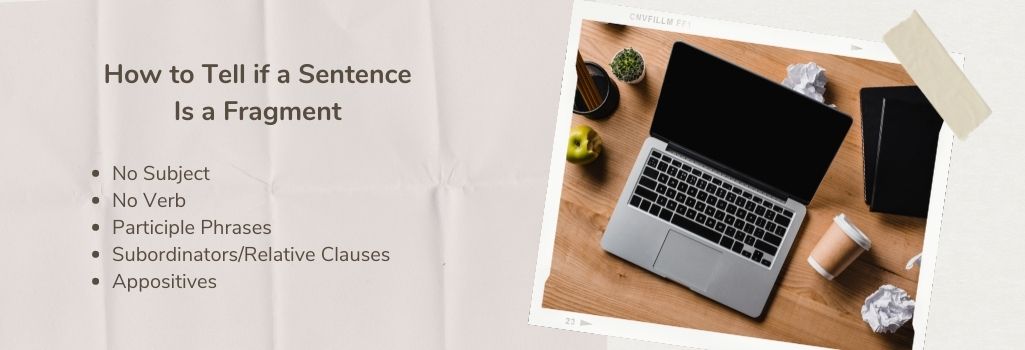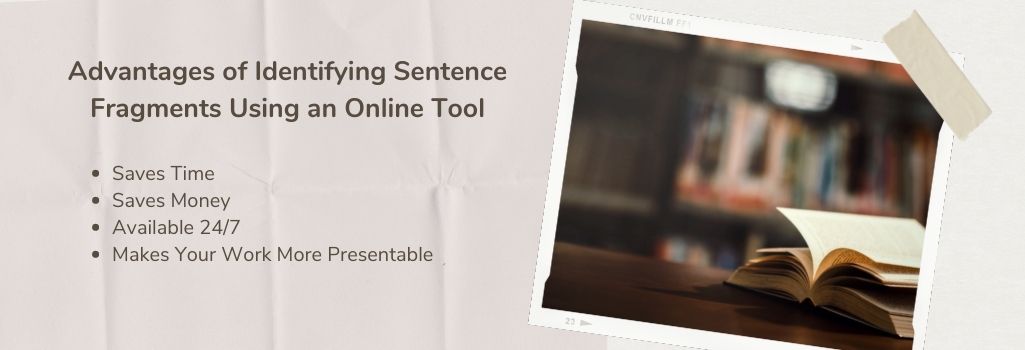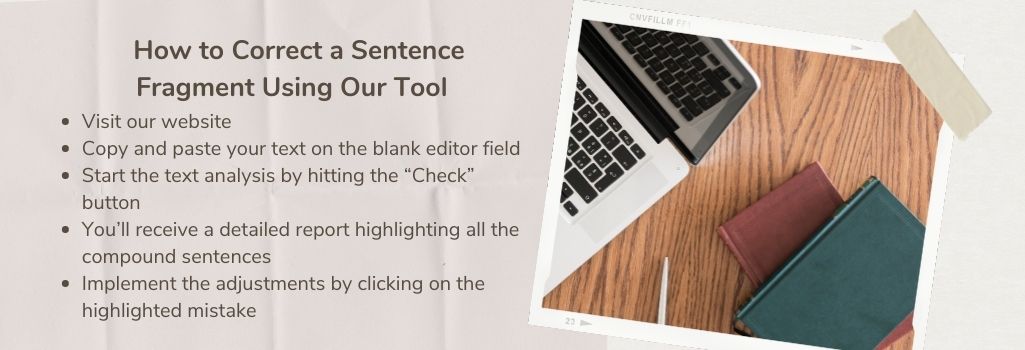Sentence fragments are incomplete sentences that lack a subject, a verb, or both. They are considered a type of error because they do not express a complete thought and can lead to confusion or miscommunication. Here are a few examples of sentence fragments:
- Walking down the street. This sentence fragment lacks a subject, so it is unclear who is walking down the street.
- Eating pizza with my friends, watching a movie afterward. This sentence fragment is a type of error called a comma splice. A comma splice occurs when two independent clauses are joined together with a comma instead of a conjunction or a period. To identify a comma splice, look for a comma separating two complete thoughts that could stand alone as their own sentences.
- Because I was tired and hungry, after work. This sentence fragment lacks a verb, so it is unclear what happened after work.
To fix a sentence fragment, you can either add a subject, a verb, or both to complete the thought, or you can combine the fragment with a nearby sentence to create a complete sentence. By learning how to identify sentence fragments and correcting them, you can improve the clarity and effectiveness of your writing. It’s important to know how to fix a fragment sentence for better quality of your text.
How to fix a fragment in an essay? Review your writing for incomplete thoughts or sentences missing either a subject or a verb. Then, add the necessary elements to create a complete sentence or combine the fragment with a nearby sentence.
In addition, we are going to explore how to identify a compound complex sentence in your work and correct them.
How To Spot A Sentence Fragment

Sentence fragments can cause confusion and make your writing less effective. Fortunately, there are several ways to spot sentence fragments and correct them. The main difference between a sentence and a fragment is that a sentence contains a complete thought and expresses a complete idea, while a fragment does not. To identify the sentence fragment, look for incomplete thoughts that are missing either a subject or a verb, or are subordinate clauses that cannot stand alone as a sentence. By learning how to identify sentence fragments, you can improve the clarity and effectiveness of your writing.
One common type of sentence fragment is a subordinate clause. A subordinate clause is a group of words that contains a subject and a verb, but cannot stand alone as a complete sentence. To identify a subordinate clause, look for words like “although,” “because,” and “while.” These words often signal the beginning of a subordinate clause. How to fix a sentence with a subordinate clause? Combine it with a nearby sentence to create a complete sentence.
Another way to spot a sentence fragment is to look for missing subjects or verbs. A sentence fragment may be missing a subject, making it unclear who or what the sentence is about. Alternatively, a sentence fragment may be missing a verb, making it unclear what action is being taken. To fix a sentence fragment with no subject or verb, add both a subject and a verb.
It’s also important to note that some sentence fragments may be part of a compound complex sentence. A compound complex sentence is a sentence that contains two or more independent clauses and one or more subordinate clauses. How to identify a compound complex sentence? Look for sentences that contain multiple independent clauses and a dependent clause. To fix a sentence fragment that is part of a compound complex sentence, combine it with a nearby clause to create a complete sentence.
Here are some examples:
1. No Subject
Example:
Fragment: Running down the street.
Fix: I was running down the street.
2. No Verb
Example:
Fragment: On the sofa all day.
Fix: I was sitting on the sofa all day.
3. No subject or verb
Example:
Fragment: While walking.
Fix: While walking, I saw a bird.
4. Subordinate clauses
Example:
Fragment: Although I was tired.
Fix: Although I was tired, I continued working.
What Is The Difference Between A Sentence And A Fragment

How to tell if a sentence is a fragment? Check if it expresses a complete thought and contains both a subject and a verb, or by identifying subordinate clauses that cannot stand alone as a sentence. So you can find the difference between sentence and fragment.
How to know if a sentence is a fragment? Check if it expresses a complete thought and contains both a subject and a verb. How to correct a sentence fragment? Just add the missing subject or verb, or combine the fragment with a nearby sentence to create a complete thought.
How To Correct A Fragment Sentence
Revising sentence fragments involves reviewing your writing for incomplete thoughts or missing elements, such as a subject or verb, and adding the necessary elements to create complete sentences. How to correct sentence fragment? Find what is missing and add it to the fragment to create a complete sentence, or combine the fragment with a nearby sentence. To fix a sentence, you need to identify any errors, such as incorrect grammar or awkward phrasing, and make the necessary revisions.
How to identify a comma splice? Look for sentences that contain two complete thoughts joined by a comma, and revise them by adding a coordinating conjunction or appropriate punctuation to separate the clauses.
If you still have a question “how to correct sentence fragments?” you can use an online tool for this. This way you can correct a sentence fragment fast and easily.

Advantages Of Using Sentence Fragments Identifier
Using a sentence fragment identifier can be a valuable tool for anyone looking to improve their writing skills. By identifying sentence fragments and correcting them, you can create clearer, more effective writing that is better organized and easier to understand. In this way, using a sentence fragment identifier can benefit you both personally and professionally. Here are some advantages of using a sentence fragment identifier and provide examples of how to identify and correct sentence fragments.
- Improved clarity. By identifying and correcting sentence fragments, your writing will be clearer and more concise. Sentence fragments can cause confusion and make it difficult for readers to understand your meaning.
- Improved writing skills. Identifying sentence fragments can help you to develop a better understanding of sentence structure and grammar rules. This can improve your overall writing skills and help you to communicate more effectively.
- Better grades. If you are a student, using a sentence fragment identifier can help you to improve your grades by ensuring that your writing is clear and well-organized.
- Professionalism. If you are writing for work or other professional purposes, using a sentence fragment identifier can help you to present a more professional image. Clear, concise writing is often seen as a sign of professionalism and competence.
- Avoiding errors. Using a sentence fragment identifier can help you to avoid common writing errors, such as comma splices and run-on sentences. This can improve the quality of your writing and make it more effective.
Overall, using a sentence fragment identifier can help you to produce clearer, more effective writing that is better organized and easier to understand. How do you correct a sentence fragment? You can spend some time and do it yourself or use online tools.
If you want to improve the clarity and effectiveness of your writing, try using a Sentence Fragments Identifier today. By identifying and correcting sentence fragments, you can create writing that is clearer, more concise, and more professional. Is this a sentence fragment checker? Yes and it will help you make texts much better.





